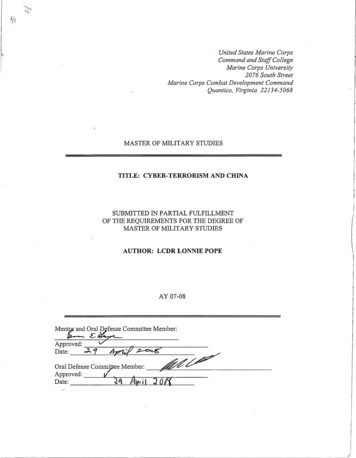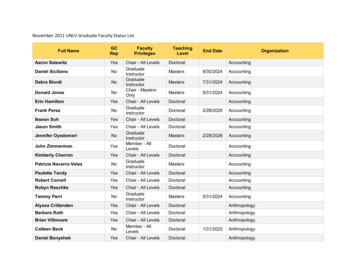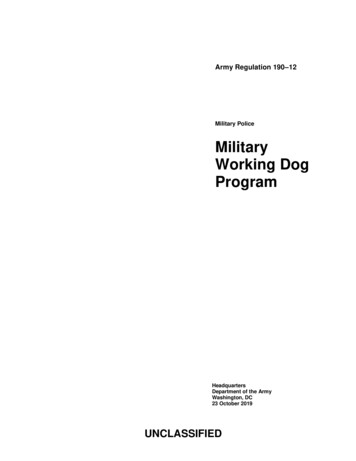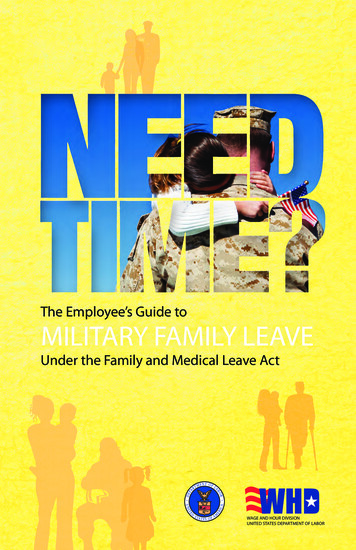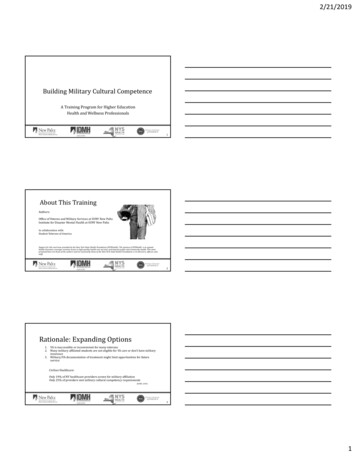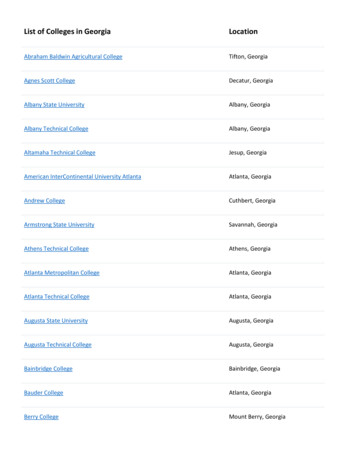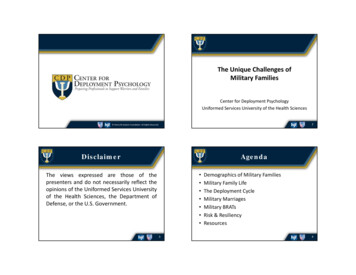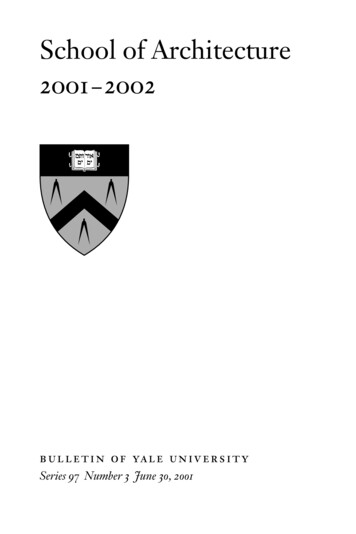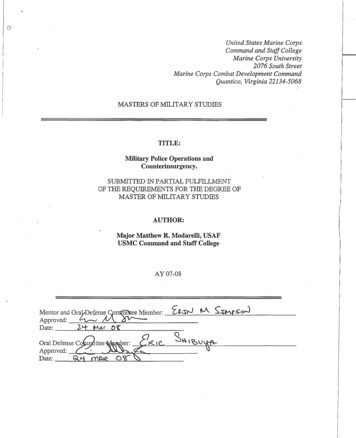
Transcription
United States Marine CorpsCommand and Staff CollegeMarine Corps University2076 South StreetMarine Corps C07nbat Development CommandQuantico, Virginia 22134-5068MASTERS OF MILITARY STUDIESTITLE:Military Police Operations andCounterinsurgency.SUBMITTED IN PARTIAL FULFILLMENTOF THE REQUIREMENTS FOR THE DEGREE OFMASTER OF MILITARY STUDIESAUTHOR:Major Matthew R. Modarelli, USAFUSMC Command and Staff CollegeAY 07-08Mentor and Ora Defens S0m(fii'ttee Member: '.:::. -- ,.J ----- -.4M.::!:- fL - --O rJApproved: -- -----,---!./ v'-.".-- '-Date:2-' Met( D9:oralDefenseCettoe .': : le. C::::::.Approved:, ----- -Date:Q.':l vnA-r . C t("
Form ApprovedOMB No. 0704-0188Report Documentation PagePublic reporting burden for the collection of information is estimated to average 1 hour per response, including the time for reviewing instructions, searching existing data sources, gathering andmaintaining the data needed, and completing and reviewing the collection of information. Send comments regarding this burden estimate or any other aspect of this collection of information,including suggestions for reducing this burden, to Washington Headquarters Services, Directorate for Information Operations and Reports, 1215 Jefferson Davis Highway, Suite 1204, ArlingtonVA 22202-4302. Respondents should be aware that notwithstanding any other provision of law, no person shall be subject to a penalty for failing to comply with a collection of information if itdoes not display a currently valid OMB control number.1. REPORT DATE3. DATES COVERED2. REPORT TYPE200800-00-2008 to 00-00-20084. TITLE AND SUBTITLE5a. CONTRACT NUMBERMilitary Police Operations and Counterinsurgency.5b. GRANT NUMBER5c. PROGRAM ELEMENT NUMBER6. AUTHOR(S)5d. PROJECT NUMBER5e. TASK NUMBER5f. WORK UNIT NUMBER7. PERFORMING ORGANIZATION NAME(S) AND ADDRESS(ES)United States Marine Corps, Command and Staff College,Marine CorpsUniversity,2076 South Street, Marine Corps Combat DevelopmentCommand,Quantico,VA,22134-50689. SPONSORING/MONITORING AGENCY NAME(S) AND ADDRESS(ES)8. PERFORMING ORGANIZATIONREPORT NUMBER10. SPONSOR/MONITOR’S ACRONYM(S)11. SPONSOR/MONITOR’S REPORTNUMBER(S)12. DISTRIBUTION/AVAILABILITY STATEMENTApproved for public release; distribution unlimited13. SUPPLEMENTARY NOTES14. ABSTRACT15. SUBJECT TERMS16. SECURITY CLASSIFICATION OF:a. REPORTb. ABSTRACTc. THIS PAGEunclassifiedunclassifiedunclassified17. LIMITATION OFABSTRACT18. NUMBEROF PAGESSame asReport (SAR)6119a. NAME OFRESPONSIBLE PERSONStandard Form 298 (Rev. 8-98)Prescribed by ANSI Std Z39-18
AcknowledgementsI would first like to thank the families and loved ones of the Air Force Office of SpecialInvestigations (OSI) special agents, my brothers, who gave their lives in the pursuit of truth andjustice in Iraq. If for no other reason, this paper illustrates the nobility of the cause for whichthey so aptly served and gave their lives. I would like to thank the 64 Airmen, Soldiers,Civilians, and Contractors that I had the honor of serving with in Iraq. The selflessness,ingenuity, courage and commitment of these men and women cannot be overstated. It was theirwar - facing seemingly insurmountable odds, they fought it and figured out how to succeed.They are silent and unsung heroes in this war. Col Kevin Jacobsen and Col Frank Malafarinaprovided me with faithful leadership, steadfast support, invaluable mentorship, recommendedreading, and personal insights on the efficacy of special investigative operations in hostile anduncertain environments. Their wisdom and decisiveness also ensured our great organization didnot shy away from the threats that face our Air Force and the Department of Defense in the 21 stCentury. Thanks to Col Scott Deacon (OSI) for sharing his innovative and often unorthodoxviews on how the DoD should organize law enforcement and security forces in the post-9/II era.A heartfelt thanks to Brig Gen Robin Rand (USAF) for taking care of his OSI units and leadingand mentoring OSI commanders in Iraq. Thanks to LTC Martin Apprich (USA) for his patience,leadership and vision while serving in an incredibly complex and challenging battalion commandin Iraq. Thanks to my faculty advisors at the USMC Command and Staff College, CDR JosephArleth (USN), Dr. Douglas Streusand and Dr. Donald Bittner, for their patience and sageguidance throughout the year. Thanks to my fellow students and interviewees (listed in the endnotes of this paper) that provided critical feedback and discussion as I developed this paper.Most of all, I want to thank my wife Diane.1
PrefaceSince the end of the Cold War, the U.S. conventional military capability has beenunrivaled by any other potential adversary. For the foreseeable future, the U.S. military canexpect be employed in irregular warfare operations involving stability and peacekeepingmissions, humanitarian assistance, and counterinsurgency (COIN). The U.S. military is currentlymired in COIN operations in Afghanistan and Iraq with no clear end in sight. In spite ofcountless historical examples, U.S. military leaders continue to struggle with fully understandingthe policing nature of security operations in COIN. To successfully put down an indigenousrebellion, security must first be established. Criminals and guerrilla leaders, often indiscernible,must be patiently identified and dealt with so that native populations can come to know justice.This effort can only be accomplished by working closely with the local population, ensuring theyhave a stake in the successful outcome of COIN operations. Only after an acceptable level ofsecurity has been established will the legitimacy of a U.S.-backed government be accepted by thelocal population; only then will U.S. military forces be able to return to garrison victorious. Inshort, law and order must be realized through the primacy of the indigenous local, state, andnational police forces. For the U.S. military to establish police primacy in places like Iraq andAfghanistan, aptly trained professionals from within the ranks must be called upon to lead theway. There will be little or no direct civilian or interagency support for this complex effort. TheDepartment of Defense must tum to its own organic law enforcement agencies for leadership ofsecurity operations in COIN.ii
I.INTRODUCTIONWithin the Department of Defense (DoD), each service is assigned military policeofficers, special investigators, and special agents charged with countering every kind ofcriminal activity. These personnel are highly skilled in obtaining evidence (i.e.actionable intelligence) to disrupt and neutralize criminals and their illicit networks. It isprecisely this skill set that when applied to an insurgency simplifies the process oftargeting and neutralizing insurgent leaders, subsequently leading to overall moreeffective security operations. Using current cultural training and linguist support, thisDoD capability could be organized immediately and assigned to jurisdictions (i.e. battlespace, province, or theater level) in a given occupied country. By adopting a militarygovernment and law enforcement (LE) command and control (C2) structure, militaryforces would be able to focus on restoring security and justice to occupied areas usingpolice techniques. Organized within a proper military government C2 structure, securityoperations could be kept in lock-step with local, provincial and theater-levelcounterinsurgency (COIN) campaigns. With no interagency support available for theforeseeable future, the DoD must turn to its own organic capabilities immediately andorganize appropriately to support the functions needed to maintain security whileproperly identifying and neutralizing insurgent leaders and groups.BackgroundIn order for the U.S. to succeed in current and future counterinsurgencies, the useof organic DoD LE capabilities must be leveraged in every facet of COIN securityoperations. A manhunt entails the use of complex police tactics, special investigativetechniques, and the recruitment and cultivation of indigenous sources to locate and
neutralize! rebel leaders. The goal of a manhunt within a COIN campaign is thesuccessful capture of enemy operatives with minimal disruption to the local civilianpopulation. This remains among the most complex of irregular warfare (IWi tasks.These investigations are highly dependent upon proper overall security procedures3 so anorganizational solution for one is directly linked to the other. Therefore, both manhuntand overall security (i.e. peacekeeping) operations will be discussed throughout thispaper with emphasis on special investigative operations and the use of indigenous peoplein pursuit of the enemy. Organic DoD LE organizations possess both peacekeeping andspecial investigation capabilities.Throughout history conventional military forces have faced insurrections byindigenous populations across the globe just as the U.S. currently faces rebel forces inAfghanistan and Iraq. Beginning in the 19th century, key theorists and doctrine emergedfrom various IW experiences from British and French colonies in Africa to the U.S. inVietnam. Pioneering theorists and practitioners laid a foundation for how to succeed inwhat the current Commander of Multinational Forces - Iraq, General David Petraeusrefers to as, "war at the graduate level".4A counterinsurgent must always take into account the effect an action will haveon the local population. No two insurgencies are exactly alike but in every case victory isdefined the same way: the people must choose the counterinsurgent's cause over that ofthe insurgents. This end is invariably dependent on the government's ability to organizeforces to provide a foundation of security and stability. Only then can the necessarysocial and economic reform programs thrive. This cannot be achieved while COINforces are not properly organized and insurgent leaders remain elusive. Large2
conventional military organizations often use excessive force to neutralize one insurgentleader or group. Such large operations have a limited success rate and often have anegative effect on civilian populations. This negative effect is then used as enemypropaganda in the ever-present struggle between rebels and counterinsurgents to win thesupport of the people. COIN forces must organize themselves for successful securityoperations that will enhance manhunt capabilities, minimizing disruption to incidentalcivilians.The U.S. generally uses conventional chains of command to conduct IW inAfghanistan and Iraq and lacks a standard construct for investigative operations. Ad-hocorganizations have been established with varying degrees of success but they remainlargely compartmentalized either within Special Operations Command (SOCOM) or aspart of service specific efforts like those of the Department of the Air Force, Office ofSpecial Investigations (OSI). Some organizations include the use of U.S. State andJustice Department personnel along with other civilian governmental organizations tobolster investigative capabilities. These interagency initiatives are not nearly robustenough to address the countrywide needs for standardized security and investigations. 5 Itis more likely that, as the former commander of Multinational Forces, Iraq, Lt Gen PeterChiarelli stated "the interagency will be broken for our lifetime.,,6 Therefore, a singleconstruct must be established to place the properly trained military personnel in the rightorganizational construct to conduct peacekeeping missions and manhunt operations aspart of a greater COIN campaign.3
II.IRREGULAR WARFARE THEORY AND DOCTRINETo understand why police operations and manhunt capabilities are necessary andhow it is employed as part of COIN, theory as documented by successful practitionersmust be examined. Lessons learned from French, British, and u.s. counterinsurgentsresulted in some baseline theory, books and publications, and doctrine that can be appliedfor successful contemporary campaigns.French TheoristsThree COIN experts and theorists evolved from the French colonial experiences.Marshals Thomas Bugeaud (1784-1849), Joseph Gallieni (1849-1916), and HubertLyautey (1854-1934) are considered fathers of French IW theory whose experiences andsubsequent teaching had a lasting impact on IW students and practitioners. Their basictheory can be summarized by understanding the challenge of irregular war in thefollowing way: "The problem is not so much 'to defeat the enemy in the most decisivemanner' as to subordinate him at the lowest cost and in a way to guarantee permanentpacification."? Therefore, occupation forces existed to secure and support the social andeconomic reconstruction programs and "military operations and the use of force wereconsigned to the background". 8 Strong emphasis on working with local populations andtransforming enemy insurgents into allies was a critical element of this theory.Also inherent within French theory is revolutionary thinking and organizationalflexibility within military and civilian systems in order to achieve political objectives.Considered the most brilliant of the three French theorists, Lyautey believed successdepended on placing the right person in the right place at the right time. He felt a trueCOIN leader "must have an open mind on everything that honors mankind".9 Lyautey4
preached patience and faith in closely screened and selected leadership. Theorganizations and methods created and employed by French COIN pioneers and theirpupils became a blueprint for success in irregular wars globally.British TheoristsThe theme of flexibility continues with Small Wars author and British COINtheorist, Colonel C.E. Callwell. According to Callwell, "irregular warfare must generallybe carried out on a method totally different from the stereotyped system. The art of war,as generally understood, must be modified to suit the circumstances of each particularcase".IO Callwell differed significantly from the French theorists in his belief that theobjective of COIN operations was a decisive defeat of the enemy by whatever meansnecessary which could include the destruction of the people and land if necessary. 11While a "decisive defeat" approach is not germane to 21st Century IW, Callwell'sresearch regarding the tracking and neutralization of insurgents remains relevant. Hegives considerable attention to the need to gain trustworthy intelligence from natives andcautions COIN operators against misinformation that can be used to exploit and attackfriendly forces. 12Inherent within French IW theory and covered in some detail by Callwell is thespecific need for reliable intelligence. This theme is prevalent among many 20 th centuryand contemporary theorists as well. In his book Defeating Communist Terrorism, BritishCOIN theorist Sir Robert Thompson stated: "It is not the aim of the intelligenceorganization merely to penetrate the insurgent movement. Its aim . must be the totaleradication of the threat". 13 He further states that while the Army is one of the mainconsumers of information in an insurgency, "it should not be a collector except in so far5
as its units obtain tactical intelligence through their operations". 14 There should be onesingle organization responsible for security intelligence and the best organization for thatmission is the special branch of the police force. ISU.S. DoctrineU.S. theory and IW doctrine stems from experiences dating back to the firstcolonial confrontation with the indigenous tribes. Following the Civil War, there was nodirect threat posed to the existence of the U.S. and "neither Army officers norgovernment officials found it necessary to work out comprehensive doctrines to be usedin dealing with Indians". 16 As a result, several years ofIW lessons were not captured inpolicy or doctrine. The U.S. Marine Corps Small Wars Manual,17 first published in 1940,and the U.S. Army Counterinsurgency manual I 8 have gained popularity since the U.S.invasions and occupations of Afghanistan and Iraq. These doctrinal works have beenproduced and/or reissued in an attempt to refocus efforts and to apply lessons learnedfrom previous wars. These documents combine elements of British and French theory.Currently, there is no clear protocol in either document for gathering evidence andconducting effective manhunt operations. In spite of the specific recommendations frommen like Thompson regarding the use of police special branch personnel for this mission,present U.S. doctrine calls for conventional military intelligence capabilities and/orSOCOM to accomplish this COIN task. Strict DoD policies govern the recruitment andcultivation of an informant for operational purposes making the process constraining andarduous. The difficulty in the process subsequently drives leadership to come up withwork-arounds or to be all together risk averse. Unfortunately, U.S. doctrine remains6
extremely conventional and generally vague regarding the proper employment of nativeinformants.21 st Century TheoryOf late, students and practitioners ofIW have expanded and adapted colonial-eraand anti-communist COIN lessons of the early theorists to the now globalized, post coldwar environment. In Parameters, the U.S. Army War College Quarterly (Winter 200708), Dr. Steven Metz makes the following argument:Contemporary insurgencies are less like traditional war where thecombatants seek strategic victory, they are more like a violent, fluid, imdcompetitive market. This circumstance is the result ofglobalization, thedecline ofthe overt state sponsorship ofinsurgency, the continuingimportance ofinformal outside sponsorship, and the nesting ofinsurgencywithin complex conflicts associated with state weakness or failure. 19Metz's goes on to explain that pre-21st Century insurgencies are less complex thantoday's insurgencies, which are caused by communal conflicts and usually involvevarious armed militias and organized criminal elements.These changes in the character of IW identified by Metz illuminate severalshortfalls in current U. S. IW doctrine. Metz argues that contemporary enemies are noworganized more along the lines of criminal networks under new leadership withpotentially selfish financial ambitions. These criminally opportunistic motivations oftensupersede any traditional insurgency desire to overthrow or replace the targeted regime.Criminal networks must be countered using arduous policing protocols at the tactical,operational, and strategic levels of war in order to gather evidence against illicit networksto be presented :within publicly sanctioned judicial systems. Current U.S. doctrine fails tomention any direct use of traditional LE capabilities against IW networks.7
Nineteenth century, French, British, and American IW theories and doctrine havesome elements that can still be applied to modem COIN operations. French theoristviews on flexibility, leadership, and a respect for persons and property remain critical tosuccessful contemporary campaigns. While Callwell's decisive victory at any cost maynot apply anymore, his thoughts on the use of indigenous scouts and informants laterexpanded upon by Thompson, remains extremely relevant. U.S. doctrine regarding theuse of native sources and subsequent policy remains conventional and vague. Metz'observations about the evolution of 21st Century insurgency highlight the uniqueorganized crime aspects of today's wars. These complex criminal-like networkshighlight the need for COIN operators to gather relevant and credible evidence. Britishtheory suggests the use of special police branch capabilities, a suggestion not consideredor addressed at all in U.S. IW doctrine. With today's widespread media coverage, thepressure on counterinsurgents to act justly and prove their actions both in local judicialproceedings and in the court of public opinion has increased exponentially. In fact, the)process by which evidence is gathered could serve to prove or disprove the U.S.legitimacy in future irregular wars. COIN theory and doctrine must be updated to reflectthe change in character of post-cold war insurgencies and the impact U.S. operationshave when viewed by a global audience.III.EXAMPLES OF IRREGULAR WARFARE OPERATIONSThroughout history, several organizations have been designed to identify andneutralize insurgent leaders in COIN campaigns. The following manhunt programs andtheir organizations will be analyzed and compared: (1) Pseudo-gangs operations inKenya (1955-1956). (2) Provincial Reconnaissance Unit (PRU) operations in Vietnam.8
(3) Selous Scouts operations in Rhodesia (1978). (4) Joint Task Force Balad (JTFB)operations in Iraq (2006-2007).Each example is unique to a specific time and conflict.Many resulted only in tactical victories whose strategic effects were never fully realizeddue to a lack of overall COIN campaign leadership. The programs employed in these IWcampaigns can provide insight in to (l) the proper employment of indigenous scouts andinformants and (2) the appropriate organization and structure of forces for futureconflicts.KenyaBy 1954, the British government had declared a state of emergency in Kenya asthe Mau Mau extremist group continued its violent insurgency against white-Europeanrule. Using primarily conventional military and local security forces to that point, thelocal government had achieved enough stability to begin necessary social and economicreform programs. However, the Mau Mau were able to maintain freedom of movementthroughout the vast jungles surrounding Mount Kenya and therefore were capable ofcarrying out violent attacks on the local population and undermining governmentlegitimacy. Conventional military forces had reached a culminating point in theircapabilities and another method was needed to gain access to native extremists.In 1954, British Army Major P.M. Slane of the Royal Inniskilling Fusiliers madethe following observation: "Certain police units have lately been working in the forestand within a battalion area it is not unusual for one rifle company to be stationed in thereserves, well back from the forest, so that they can assist the Police and Home Guard".2oAs time went on, the Army became almost entirely dependent on the police for up-to-dateintelligence and eventually became a supporting effort for what is referred to as pseudo-9
gang operations. Pseudo-gangs were captured insurgents that agreed to work under thecontrol of counterinsurgents and were organized into gangs trained to identify andneutralize insurgent groups. Pseudo-gangs operations were placed under civilian controlvia the Kenyan Police special branch so that police special agents could directly handlekey informants. Police operations were coordinated via civil-military operations centersto fuse efforts. Overall C2 resided with General Sir Gerald Lathbury who controlled allmilitary and civilian security operations for the campaign. He created a Special Forcespolice section specifically to enhance pseudo-gang operations and guararttee full militaryand civilian police support. This tactic when used by the local police force "provedprobably the most successful of all methods employed".21 By creating a separate,focused special police branch and coordinating operations in a civil-military fusion cell,British civilian and military efforts could be coordinated in order to ensure full support ofthe manhunt effort while de-conflicting operations with on:'going military, social andeconomic reform programs.VietnamIn 1967, CIA officers working with provincial leaders throughout Vietnamrecognized the need for a localized capability to hunt down enemy guerrilla leaders andgroups. Local Vietnamese leaders complained that "the formal military units in theirareas were either not under their command or were ill armed and poorly trained foraggressive operations".22 Local leaders took note of CIA's flexibility and welcomed theiraid.In response, a number of provinces developed Provincial Reconnaissance Units(PRU), comprised of tough local militia paid by the CIA. The CIA screened and handpicked U.S. military officers to command the PRUs.These units were capable of10
gathering their own intelligence and conducting their own direct action operations andtherefore constituted, as was recommended by Sir Robert Thompson, a singleorganization able to both "penetrate" the insurgency and "eradicate" threats. PRU teamswere designed to fall under the direct control of the local provincial leader allowing himto effectively campaign against the insurgency within a specific area. The PRUs becameextremely effective as a localized initiative working within the dispersed villages andpopulations.23PRUs were designed to complement and enhance other local police capabilitieswith all efforts synchronized via district intelligence operations coordination cells(DIOCC). While DIOCCs were aptly positioned and organized to fuse operations, theywere rarely universally embraced. Former Tay Ninh province PRU commander Col(Ret) Andrew R. Finlayson (USMC) explained that the single most frustrating aspect ofPRU operations was the bureaucratic barriers and competitive infighting that existedbetween similarly capable local entities: "Petty jealousies between the VietnameseNational Police, the Vietnamese Special Branch Police, and district chiefs oftenprevented the transmission of good operational leads to the PRU. ,,24 The benefits ofworking together were often overcome by competitive personalities that preferred stovepiped operations to the risk of having another organization potentially steal credit for asuccessful operation. Downward-directed national level policy eventually reduced theamount of friction between the various offices but institutional synergy via the DIOCCwas never fully achieved. 25The creation of the PRU came at a time when the CIA was struggling to convinceconventional military leadership of the importance rural populations played in supporting11
or countering the Vietcong Infrastructure (VCI or shadow government) that existed insouthern Vietnam.Operating within southern Vietnam, PRUs were careful to employpolice protocols and use judicial processes to properly discriminate and validate targetsfor neutralization. 26 Coalition police and military units were simultaneously furnishedwith a plethora of current intelligence and threat information. The success of PRUs waseventually recognized at the national level and led to the establishment of the infamousPhuong Hoang (Phoenix) program. This national affiliation was quickly exploited byenemy propaganda both within the U.S. and in Vietnam that deceitfully advertised PRUsas assassination squads. In reality most PRU operations ended in the successful captureand prosecution of VCI personnel with just "14 percent" killed in skirmishes or as aresult of resisting arrest,27In fact, PRUs were so effective that by the time thecommunists laid siege to Tay Ninh during their 1975 invasion, just six VCI memberscould be mustered from an entire province. Nonetheless, effective enemy-backed 10campaigns pushed widespread misinformation about PRUs and the U.S. in tumterminated support for the program. As with many COIN programs, local initiatives likePRUs are often misunderstood and subsequently terminated in spite of their significantstrategic effects for provincial and theater-level COIN campaigns. 28RhodesiaIn the 1970s in Southern Rhodesia (now known as Zimbabwe), the Selous Scoutswere formed from the Rhodesian special forces to counter the black nationalist guerillaforces who were conducting effective raids into Southern Rhodesia from safe havens inthe now seceded neighboring states of Zambia and Mozambique. Rhodesia was acountry independent of direct British rule, but was still governed by a small white12
population that imposed oppressive laws on the predominately black indigenouspeoples. 29Faced with a growing movement against the government and equipped with asmall, overworked military force, the Selous Scouts were formed to hunt down guerillagroups in the toughest terrain and across recognized enemy borders. They werecomprised of 1000 men with a large majority of blacks and some mercenaries. TheSelous Scouts were largely local peoples and masters of the terrain. Using their hunting\,skills, Selous Scouts would often track groups of guerillas through the jungles for up to aweek at a time. A typical Selous Scout team was comprised of six personnel. Themakeup of the team included a white controller and a turned guerilla operating as a scoutunder the direct control of the team. 30 Selous Scouts were capable of disguising asguerrillas and entering enemy encampments to gather information and neutralize guerrillagroups. The Selous Scouts were widely viewed by those who supported the Rhodesianregime as "a group of experts providing the eyes and ears of the main body of securityforces".31The Selous Scouts were a function of the Rhodesian Special Forces, whichincluded other elements like the Special Air Service and Grey's Scouts (a horse mounted200-man dragoon unit). However, the complexity and political risk associated withSelous Scout operations required close civilian oversight and C2. For this reason, the C2of Selous Scouts fell within the Special Branch of the British South African Police chainof command that, like in Kenya, utilized j oint operations centers for coordination of civiland military COIN efforts. 3213
Iraq33Joint Task Force Balad (JTFB) was first established in 2004 and based out ofBalad Airbase in central Iraq. The task force was designed to provide enhanced freedomof movement and security to OSI augmented by u.s. Army counterintelligence andhuman intelligence (CIIHUMINT) personnel for the conduct of information gatheringmissions for base defense. In the fall of 2005 the task force was shut down and laterreinstituted in May of2006. In June 2006, in accordance with Air Force MissionDirective 39 (AFMD 39 - OSI Mission, signe
government and law enforcement (LE) command and control (C2) structure, military forces would be able to focus on restoring security andjusticeto occupied areas using police techniques. Organized within a proper military government C2 structure, security operations could be kept in lock-stepwith local, provincial and theater-level
